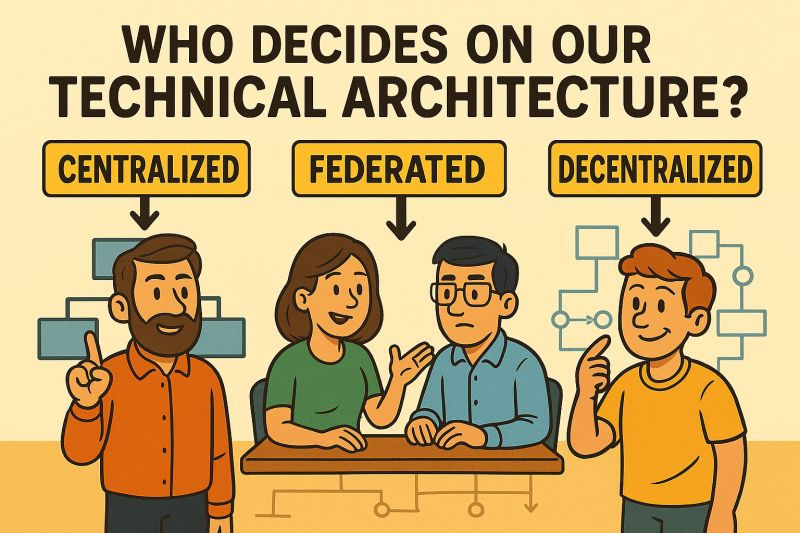📬 𝗦𝗵𝗼𝘂𝗹𝗱 𝘄𝗲 𝗯𝗿𝗲𝗮𝗸 𝘂𝗽 𝘁𝗵𝗲 𝗺𝗼𝗻𝗼𝗹𝗶𝘁𝗵?
- Kjell Moens

- Jul 29
- 2 min read
𝘚𝘺𝘴𝘵𝘦𝘮 𝘈𝘳𝘤𝘩𝘪𝘵𝘦𝘤𝘵𝘶𝘳𝘦 & 𝘛𝘦𝘤𝘩𝘯𝘪𝘤𝘢𝘭 𝘚𝘵𝘳𝘢𝘵𝘦𝘨𝘺 𝘴𝘦𝘳𝘪𝘦𝘴

The architecture team asked me this during a technical review.
Their monolithic application was getting harder to deploy.
New features were taking longer.
The team felt like they were all stepping on each other's code.
"Microservices will solve this," they said.
But here's what I've learned after seeing companies make this transition:
𝗠𝗶𝗰𝗿𝗼𝘀𝗲𝗿𝘃𝗶𝗰𝗲𝘀 𝗮𝗿𝗲 𝗮𝗻 𝗼𝗿𝗴𝗮𝗻𝗶𝘇𝗮𝘁𝗶𝗼𝗻𝗮𝗹 𝗽𝗮𝘁𝘁𝗲𝗿𝗻, 𝗻𝗼𝘁 𝗷𝘂𝘀𝘁 𝗮 𝘁𝗲𝗰𝗵𝗻𝗶𝗰𝗮𝗹 𝗼𝗻𝗲.
Before you break up your code, ask:
→ Can your teams work independently?
→ Do you have clear service boundaries?
→ Can you handle distributed system complexity?
→ Do you have the operational maturity for multiple deployments?
𝗧𝗵𝗲 𝗽𝗮𝗶𝗻𝗳𝘂𝗹 𝗿𝗲𝗮𝗹𝗶𝘁𝘆: Premature microservices create distributed monoliths.
You get all the complexity of distributed systems with none of the benefits of independent services.
Here's the framework I use:
𝗢𝗿𝗴𝗮𝗻𝗶𝘇𝗮𝘁𝗶𝗼𝗻𝗮𝗹 𝗥𝗲𝗮𝗱𝗶𝗻𝗲𝘀𝘀:
• Teams can own services end-to-end
• Clear communication patterns between teams
• Independent deployment cycles
• Service-oriented culture
𝗧𝗲𝗰𝗵𝗻𝗶𝗰𝗮𝗹 𝗥𝗲𝗮𝗱𝗶𝗻𝗲𝘀𝘀:
• Well-defined domain boundaries
• Mature CI/CD pipeline
• Monitoring and observability
• Database per service strategy
Most companies rush to microservices when they should fix their monolith first:
• Better module boundaries
• Cleaner APIs between components
• Improved deployment process
• Team ownership of specific areas
𝗧𝗵𝗲 𝗶𝗻𝘀𝗶𝗴𝗵𝘁 𝘁𝗵𝗮𝘁 𝗰𝗵𝗮𝗻𝗴𝗲𝗱 𝗲𝘃𝗲𝗿𝘆𝘁𝗵𝗶𝗻𝗴:
🧠Microservices don't solve organizational problems —they expose them.
If your teams can't coordinate on a monolith, they definitely can't coordinate on distributed services. Start with organizational boundaries. The technical boundaries will follow.
🗣️ What's your experience with monolith-to-microservices transitions? Have you seen teams succeed or struggle with this shift? Let me know your thoughts in the comments
🙏 I help scale-ups design the systems, teams, and technical strategy they need to grow — without burning out, breaking down, or bottlenecking the business.
🔁 Like this kind of thinking? Follow along for more — or book a quick, no-pressure call.



Comments